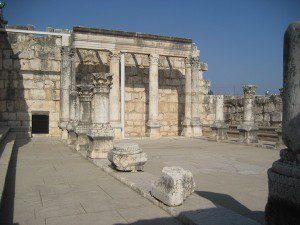
Each lesson covers a good number of stories. Today covers Mark 1-2, among others. Mark is generally thought to be the earliest gospel, though not the earliest NT book. Paul’s letters were all written before the Gospels, with Galatians probably being the earliest book written. (NB: That’s the date of composition, not the date of the events described nor the date of our earliest manuscripts.) Mark’s gospel also uses rougher Greek, and a gospel of action. Note how many times “straightway” and “immediately” appear in Mark, both translating euthus. Of the 50x euthus appears in the Gospels, Mark has 41 of them, creating a sense of action and immediacy.
Jesus at Home
I love the story in Mark 2:1-12. Jesus is “at home” in Capernaum. That is where Peter’s house was, where Jesus heals Peter’s mother (Matthew 8:14). Jesus preached in the synagogue there, partially built with the financial support of the centurion (Luke 7:1, 4-5) whose servant he heals.
Most people don’t realize that this was probably Jesus’ own house. He had moved to Capernaum from Nazareth; the point of the first two verses is that when Jesus returned from his short preaching trip around the neighbouring villages, he found crowds pressing around the door as though he were a movie star or well-known footballer. Jesus himself was the unlucky householder who had his roof ruined that day.- Tom Wright, Mark for Everyone, 16.
I’m not sure how to reconcile the idea of Jesus having a house in Capernaum with Jesus as the wandering preacher, with “nowhere to lay his head.” (Matt 8:20, Luke 9:58). Perhaps he established a home earlier as any Jewish man would do, and then sold it to support himself going about preaching? Or is it more likely that he stayed with Peter and Andrew so much in Capernaum that their house was “home” to him?
In any case, there at home, surrounded by a large crowd, four people come with their paralyzed friend, on his “bed.” (Beds were typically just mats.) They can’t get through the crowd, so they go up on the roof of the house. (Roofs were typically flat, and houses often had a stairway on the outside to get up to it.) Then, the KJV says they “uncovered the roof… and broke it up.” They “deroof the roof” and then “dig it up”, due to the probable mud/thatch roof layers. (Luke 5:19 mentions “tiles”, however.)
They lower him down, and Jesus, totally unfazed by people having just made a human-size hole in his roof, says “your sins are forgiven.” Some of the crowd does not appreciate this blasphemy, since God alone can forgive sins. I imagine that Jesus had a wry grin at times such as this.
‘Answer me this,’ [Jesus] went on. ‘Is it easier to say to this cripple “Your sins are forgiven”, or to say, “Get up, pick up your stretcher, and walk”? ‘You want to know that the son of man has authority on earth to forgive sins?’ He turned to the paralytic. ‘I tell you,’ he said, ‘Get up, take your stretcher, and go home.’ 12 He got up, picked up the stretcher in a flash, and went out before them all.- Tom Wright, Mark for Everyone, 16.
Anyone can say anything they want, of course. It’s just as easy to say one thing as another. But to speak and change the nature of reality?
“Everyone was astonished, and they praised God. ‘We’ve never seen anything like this!’ they said.”
And that was exactly the point. Jesus could both forgive sins and heal the sick with a word. Even after they vandalized his house.
Tidbits:
- On Mark 1:4 and “the baptism of repentance for the remission of sins”-
A much more expansive translation that conveys the meaning admirably is the twenty-two English words that Cassirer used to render Mark’s five words in Greek, baptisma metanoias eis aphesin hamartion (1:4): “a baptism which was to have its source in repentance and which was to result in people having their sins forgiven them.” Metzger, Bible in Translation: Ancient and English Versions, 145.
- Peter’s house has been located, with a good probability of being correct. See this article with pictures.
Lastly, as always, you can support this site and my research by making Amazon purchases through this link, or the Support My Research links at the bottom of the About page. You can get updates by email whenever a post goes up (subscription box on the right). If you friend me on Facebook, please drop me a note telling me you’re a reader.












